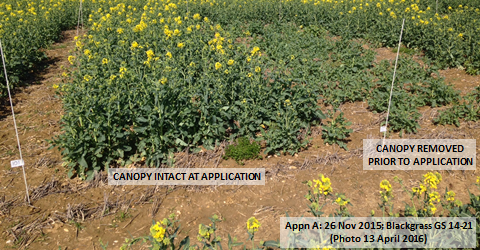Work done last year in the UK has answered a frequently asked question from advisors “ is it OK to spray Kerb Flo 500 with a rape canopy is intact?” The objective of spraying either Kerb or ASTROkerb is to create an even layer of herbicide (propyzamide) across the soil profile so that when the weeds germinate in and through this layer they pick up a lethal dose of the herbicide. For best results the temptation of spraying too early must be avoided because if the soil temperature is too high the residual activity of the propyzamide is reduced. The half-life of propyzamide at 10ºC is around 100 days whereas at 15ºC the half-life falls to 60 days. However practically if you go later, will the crop canopy interfere with blackgrass control?
“We have consistently advised waiting to make applications of Kerb and ASTROKerb until soil temperatures have got down to 10ºC and falling at 30 centimetres depth and there is sufficient moisture in the soil for plant uptake. Applications when soils are too warm may result in 5% or 10% less control of black-grass, which you really cannot afford if you are trying to get on top of black-grass,” says Peter Waite of Dow AgroSciences.
“These two key conditions of application, soil temperature and moisture, are rarely met before November. This year temperatures are just about coming right now, as we move into mid-to late November. In answer to the agronomists query, will large canopies interfere with black-grass control, new UK trials data show clearly that even where crop canopies are dense, excellent black-grass control can be achieved, providing optimum soil conditions are met. A full oilseed rape crop canopy at time of application makes no difference to final levels of blackgrass control when using Kerb Flo 500. Waiting for optimal soil conditions, i.e. soil temperature at 30 centimetres is <10oC and declining and soils are moist, is still the correct approach, regardless of ground cover from a well-developed crop canopy. The latest field-based research data proves our advice remains current, correct and fully effective (See graph). In these trials half the trial had the crop canopy was removed, whilst the remainder was left intact. The Kerb Flo 500 was applied at 2 timings, the first when black-grass was 14-21 on 26 Nov and the second on 4 Jan when black-grass was GS 15 to 25. Weed control was assessed up to 112 days after application but very little difference was seen.”
ASTROKerb and Kerb Flo 500 have the same conditions of application and the same wide application window of four months, starting from the 1st of October through to the end of January. “ASTROKerb delivers the same weed spectrum as Kerb Flo 500, with the addition of mayweed species and common poppy. We would expect activity on sow thistle and groundsel too,” he says.
“Advisors should also use our traffic light system to give an indication of whether conditions are moving towards optimal. Weather data reports for advisors and growers are on the Dow AgroSciences web site or sent out directly. They can also get graphs of soil temperatures and moisture deficits over time in several locations. This means that all agronomists are well supported and are able to assess the right information so they can get the very best from propyzamide-containing herbicides. Kerb Flo 500 and ASTROKerb should be given the chance to work as best as they can, as many growers are using oilseed rape as a true break crop once again,” says Peter.
Peter says that if application conditions are just right, farmers can expect levels of black-grass control from Kerb Flo 500 and ASTROKerb that are frequently over 90%, a level that few other herbicides are currently achieving in any other arable crop.
“Maintaining stewardship of residual herbicides in oilseed rape is very important to ensure the long term availability of these herbicides and every manufacturer, agronomist and grower needs to take on their responsibility seriously.”
“Kerb Flo 500 and ASTROKerb may be applied in frosty conditions but application onto frozen ground where subsequent rainfall could result in run-off into watercourses should be avoided. Excellent weed control has been seen from December or January applications,” Peter says.
“Another question we get frequently on our technical hotline, is do I need a dry-leaf for application? The propyzamide in Kerb 500 is soil acting, so spraying wet weeds at run off or light rainfall after application is not an issue. For ASTROKerb, however which has a contact acting aminopyralid element, spraying on a dry leaf is OK, but if rainfall is forecast within one hour, then delay applications. In both cases, do not spray where there is any risk of run-off to adjacent watercourses. Care must be taken to avoid any risk of contamination to water and importantly, all aspects of good Stewardship adhered to,” he says.




